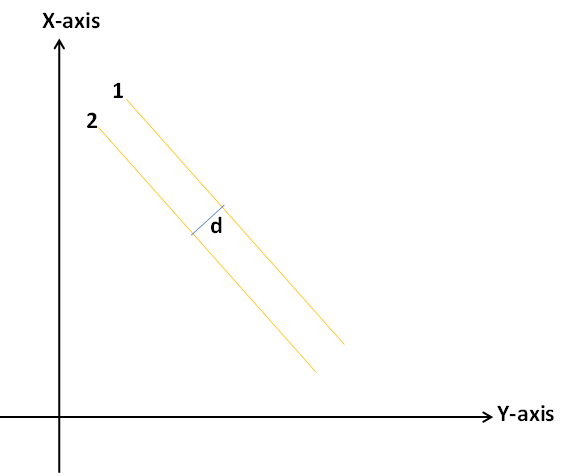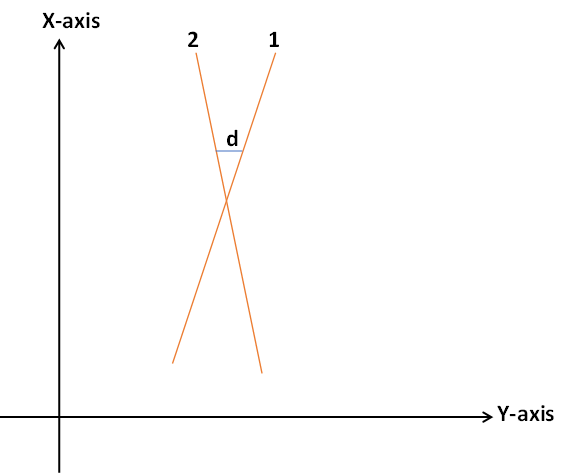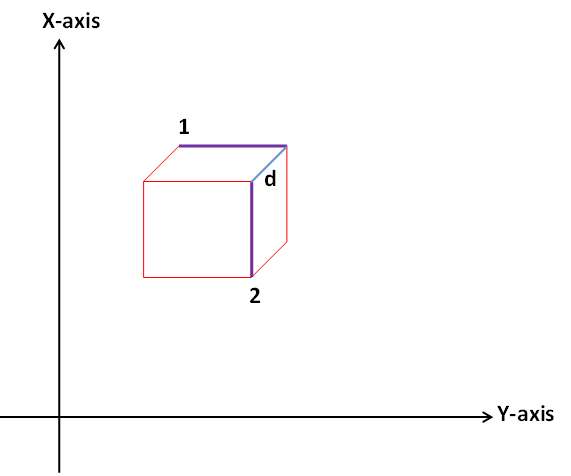
The shortest distance between the line ${\vec{r}}_1=4\vec{i}-3\vec{j}-\vec{k}+\lambda(\vec{i}-4\vec{j}+7\vec{k})$ and ${\vec{r}}_2=\vec{i}-\vec{j}-10\vec{k}+\lambda(2\vec{i}-3\vec{j}+8\vec{k})$ is –
A. 3
B. 1
C. 2
D. 0
Answer
216.3k+ views
Hint: To determine the shortest distance between any two lines we must determine the shortest distance between any two points on both lines. There are different types of lines: parallel lines, intersecting lines, and skew lines.
1. Parallel lines

All distance between parallel lines will be the same/constant.
2. Intersecting lines

The shortest distance between the intersecting lines will be zero.
3. Skew lines

Formula used: The formula to determine the distance between the lines $r_1=a_1+\lambda b_1$ and $r_2=a_2+\lambda b_2$ are –
$d=\left\bracevert\dfrac{(a_2-a_1).(b_1\times b_2)}{\left|b_1\times b_2\right|}\right\bracevert$
Complete step by step solution: Given, the equations of the lines are –
${\vec{r}}_1=4\vec{i}-3\vec{j}-\vec{k}+\lambda(\vec{i}-4\vec{j}+7\vec{k})$ ---------- (i)
${\vec{r}}_2=\vec{i}-\vec{j}-10\vec{k}+\lambda(2\vec{i}-3\vec{j}+8\vec{k})$ ---------- (ii)
We know that to determine the shortest distance between the lines-
$r_1=a_1+\lambda b_1$ and $r_2=a_2+\lambda b_2$
$d=\left\bracevert\dfrac{(a_2-a_1).(b_1\times b_2)}{\left|b_1\times b_2\right|}\right\bracevert$
On comparing the equations (i) and (ii) with equations of lines $[ r_1=a_1+\lambda b_1 ]$ and $[ r_2=a_2+\lambda b_2 ]$ respectively
$a_1=4\vec{i}-3\vec{j}-\vec{k}$ and $a_2=\vec{i}-\vec{j}-10\vec{k}$
$b_1=\vec{i}-4\vec{j}+7\vec{k}$ and $b_2=2\vec{i}-3\vec{j}+8\vec{k}$
$a_2-a_1=\vec{i}-\vec{j}-10\vec{k}-(4\vec{i}-3\vec{j}-\vec{k})$
$a_2-a_1=\vec{i}-\vec{j}-10\vec{k}-4\vec{i}+3\vec{j}+\vec{k}$
$a_2-a_1=-3\vec{i}+2\vec{j}-9\vec{k}$
${b}_{1}\times{b}_{2}=\vec{{i}}[(-{4})\times{8}-{7}\times(-{3})]-j[(7×2)-(8×1)]-k[(-3)×1-2×(-4)]$
${b}_{1}\times{b}_{2}=\vec{{i}}[(-{32})-(-{21})]+j[(14)-(8)]-k[(-3)-(-8)]$
${b}_{1}\times{b}_{2}=\vec{{i}}[(-{32})+({21})]+j[(14)-(8)]-k[(-3)-(-8)]$
${b}_{1}\times{b}_{2}=-{11}\vec{{i}}+{6}\vec{{j}}+{5}\vec{{k}}$
$(a_2-a_1).(b_1\times b_2)=(-3\vec{i}+2\vec{j}-9\vec{k}).(-{11}\vec{{i}}+{6}\vec{{j}}+{5}\vec{{k}})$
$(a_2-a_1).(b_1\times b_2)=(-3).(-{11})(\vec{{i}}.\vec{i})+(2.{6})(\vec{{j}}.\vec{j})+(-9).(-{5})(\vec{{k}}.\vec{k})$
As we know that $(\vec{{i}}.\vec{i})=(\vec{{j}}.\vec{j})=(\vec{{k}}.\vec{k})=1$
$(a_2-a_1).(b_1\times b_2)={33}+12-45$
$a_2-a_1).(b_1\times b_2)={45}-45$
$(a_2-a_1).(b_1\times b_2)={0}$
$\left|b_1\times b_2\right|=\sqrt{{(-11)}^2+{(6)}^2+{(5)}^2}$
$\left|b_1\times b_2\right|=\sqrt{121+36+25}$
$\left|b_1\times b_2\right|=\sqrt{182}$
$d=\left|\frac{(a_2-a_1).(b_1\times b_2)}{\left|b_1\times b_2\right|}\right|=\frac{0}{\sqrt{182}}=0$
Hence the shortest distance between the line [ ${\vec{r}}_1=4\vec{i}-3\vec{j}-\vec{k}+\lambda(\vec{i}-4\vec{j}+7\vec{k}) ]$ and $[ {\vec{r}}_2=\vec{i}-\vec{j}-10\vec{k}+\lambda(2\vec{i}-3\vec{j}+8\vec{k}) ]$ is 0.
Thus, Option (D) is correct.
Note: The direction ratios (a, b, c) are components of vector with respect to x-axis, y-axis, and z-axis respectively and direction cosines (l, m, n) are the angle subtended by the line with x-axis, y-axis, and z-axis respectively.
1. Parallel lines

All distance between parallel lines will be the same/constant.
2. Intersecting lines

The shortest distance between the intersecting lines will be zero.
3. Skew lines

Formula used: The formula to determine the distance between the lines $r_1=a_1+\lambda b_1$ and $r_2=a_2+\lambda b_2$ are –
$d=\left\bracevert\dfrac{(a_2-a_1).(b_1\times b_2)}{\left|b_1\times b_2\right|}\right\bracevert$
Complete step by step solution: Given, the equations of the lines are –
${\vec{r}}_1=4\vec{i}-3\vec{j}-\vec{k}+\lambda(\vec{i}-4\vec{j}+7\vec{k})$ ---------- (i)
${\vec{r}}_2=\vec{i}-\vec{j}-10\vec{k}+\lambda(2\vec{i}-3\vec{j}+8\vec{k})$ ---------- (ii)
We know that to determine the shortest distance between the lines-
$r_1=a_1+\lambda b_1$ and $r_2=a_2+\lambda b_2$
$d=\left\bracevert\dfrac{(a_2-a_1).(b_1\times b_2)}{\left|b_1\times b_2\right|}\right\bracevert$
On comparing the equations (i) and (ii) with equations of lines $[ r_1=a_1+\lambda b_1 ]$ and $[ r_2=a_2+\lambda b_2 ]$ respectively
$a_1=4\vec{i}-3\vec{j}-\vec{k}$ and $a_2=\vec{i}-\vec{j}-10\vec{k}$
$b_1=\vec{i}-4\vec{j}+7\vec{k}$ and $b_2=2\vec{i}-3\vec{j}+8\vec{k}$
$a_2-a_1=\vec{i}-\vec{j}-10\vec{k}-(4\vec{i}-3\vec{j}-\vec{k})$
$a_2-a_1=\vec{i}-\vec{j}-10\vec{k}-4\vec{i}+3\vec{j}+\vec{k}$
$a_2-a_1=-3\vec{i}+2\vec{j}-9\vec{k}$
${b}_{1}\times{b}_{2}=\vec{{i}}[(-{4})\times{8}-{7}\times(-{3})]-j[(7×2)-(8×1)]-k[(-3)×1-2×(-4)]$
${b}_{1}\times{b}_{2}=\vec{{i}}[(-{32})-(-{21})]+j[(14)-(8)]-k[(-3)-(-8)]$
${b}_{1}\times{b}_{2}=\vec{{i}}[(-{32})+({21})]+j[(14)-(8)]-k[(-3)-(-8)]$
${b}_{1}\times{b}_{2}=-{11}\vec{{i}}+{6}\vec{{j}}+{5}\vec{{k}}$
$(a_2-a_1).(b_1\times b_2)=(-3\vec{i}+2\vec{j}-9\vec{k}).(-{11}\vec{{i}}+{6}\vec{{j}}+{5}\vec{{k}})$
$(a_2-a_1).(b_1\times b_2)=(-3).(-{11})(\vec{{i}}.\vec{i})+(2.{6})(\vec{{j}}.\vec{j})+(-9).(-{5})(\vec{{k}}.\vec{k})$
As we know that $(\vec{{i}}.\vec{i})=(\vec{{j}}.\vec{j})=(\vec{{k}}.\vec{k})=1$
$(a_2-a_1).(b_1\times b_2)={33}+12-45$
$a_2-a_1).(b_1\times b_2)={45}-45$
$(a_2-a_1).(b_1\times b_2)={0}$
$\left|b_1\times b_2\right|=\sqrt{{(-11)}^2+{(6)}^2+{(5)}^2}$
$\left|b_1\times b_2\right|=\sqrt{121+36+25}$
$\left|b_1\times b_2\right|=\sqrt{182}$
$d=\left|\frac{(a_2-a_1).(b_1\times b_2)}{\left|b_1\times b_2\right|}\right|=\frac{0}{\sqrt{182}}=0$
Hence the shortest distance between the line [ ${\vec{r}}_1=4\vec{i}-3\vec{j}-\vec{k}+\lambda(\vec{i}-4\vec{j}+7\vec{k}) ]$ and $[ {\vec{r}}_2=\vec{i}-\vec{j}-10\vec{k}+\lambda(2\vec{i}-3\vec{j}+8\vec{k}) ]$ is 0.
Thus, Option (D) is correct.
Note: The direction ratios (a, b, c) are components of vector with respect to x-axis, y-axis, and z-axis respectively and direction cosines (l, m, n) are the angle subtended by the line with x-axis, y-axis, and z-axis respectively.
Recently Updated Pages
JEE Atomic Structure and Chemical Bonding important Concepts and Tips

JEE Amino Acids and Peptides Important Concepts and Tips for Exam Preparation

Electricity and Magnetism Explained: Key Concepts & Applications

Chemical Properties of Hydrogen - Important Concepts for JEE Exam Preparation

JEE Energetics Important Concepts and Tips for Exam Preparation

JEE Isolation, Preparation and Properties of Non-metals Important Concepts and Tips for Exam Preparation

Trending doubts
JEE Main 2026: Application Form Open, Exam Dates, Syllabus, Eligibility & Question Papers

Derivation of Equation of Trajectory Explained for Students

Hybridisation in Chemistry – Concept, Types & Applications

Understanding the Angle of Deviation in a Prism

Understanding Collisions: Types and Examples for Students

How to Convert a Galvanometer into an Ammeter or Voltmeter

Other Pages
JEE Advanced Marks vs Ranks 2025: Understanding Category-wise Qualifying Marks and Previous Year Cut-offs

Ideal and Non-Ideal Solutions Explained for Class 12 Chemistry

Degree of Dissociation: Meaning, Formula, Calculation & Uses

Understanding Electromagnetic Waves and Their Importance

Understanding the Electric Field of a Uniformly Charged Ring

Understanding Average and RMS Value in Electrical Circuits




